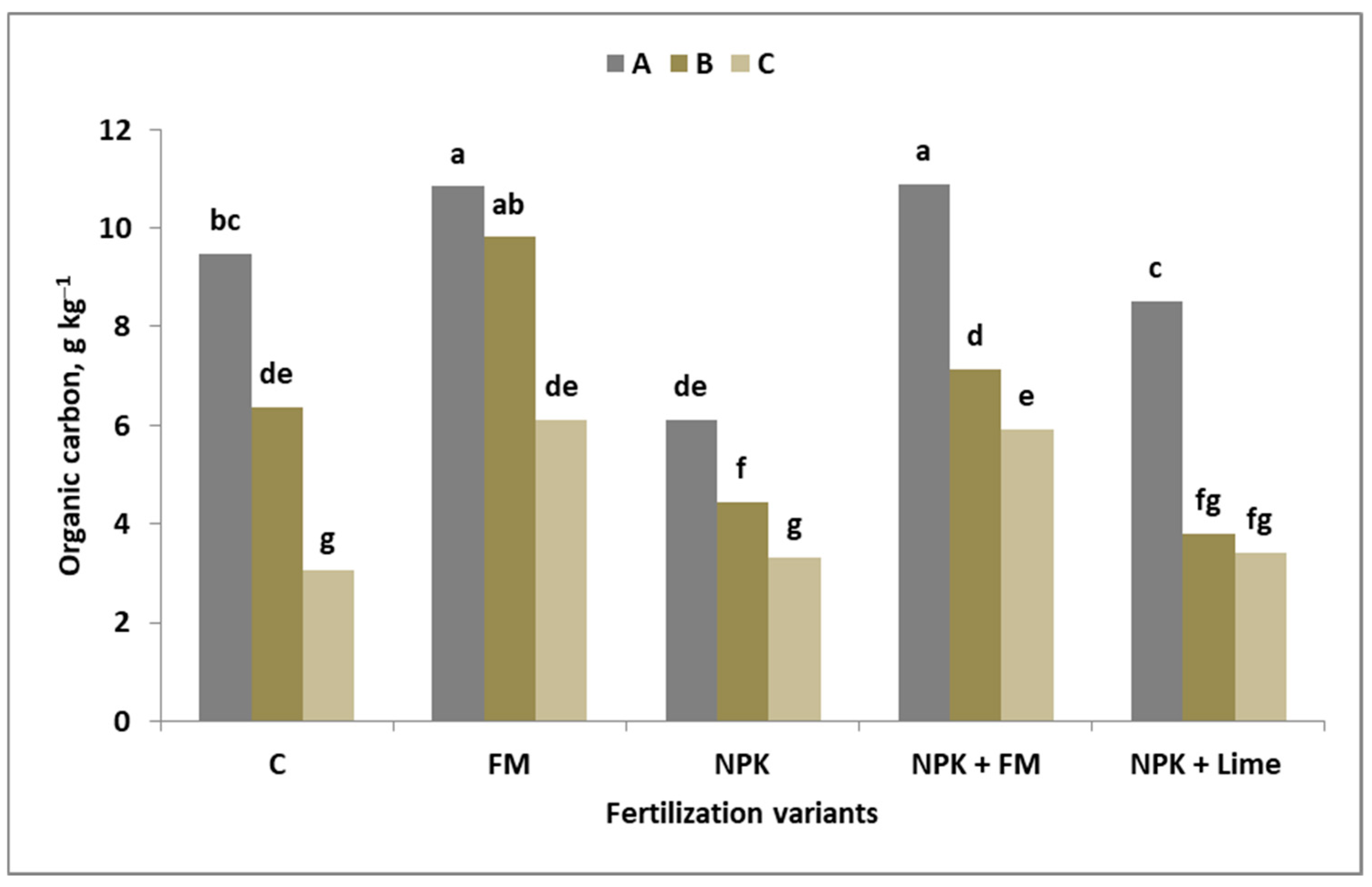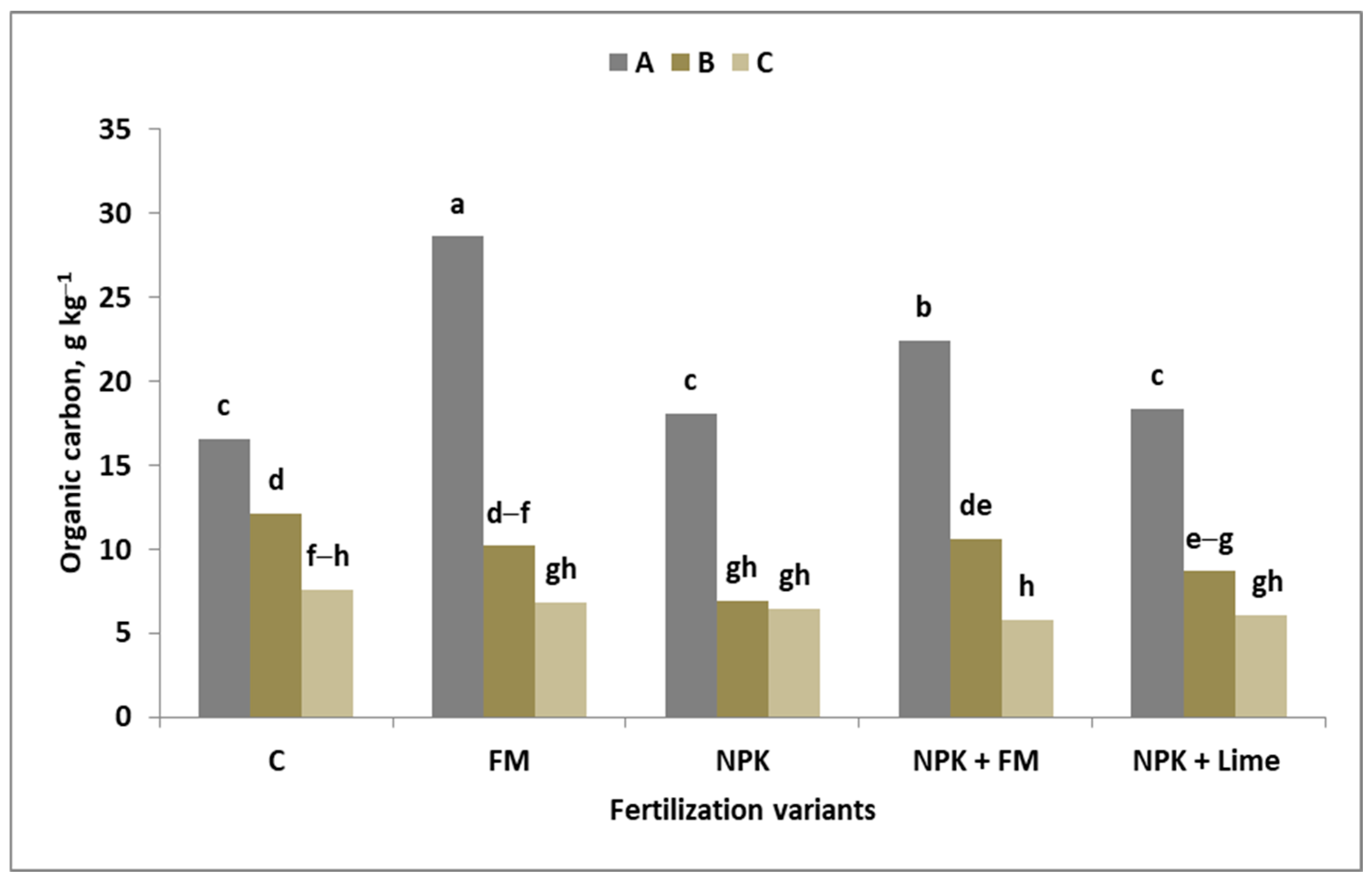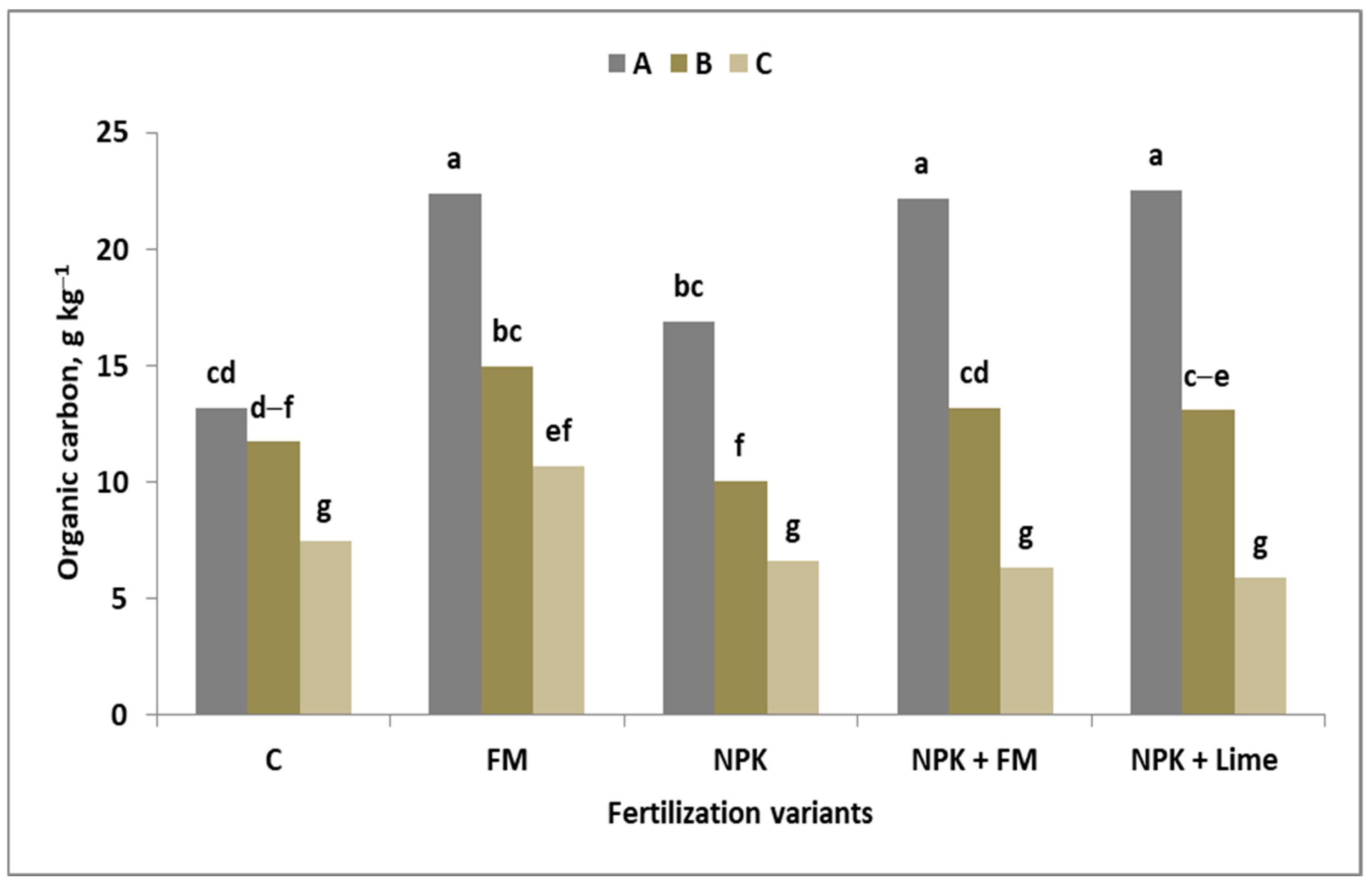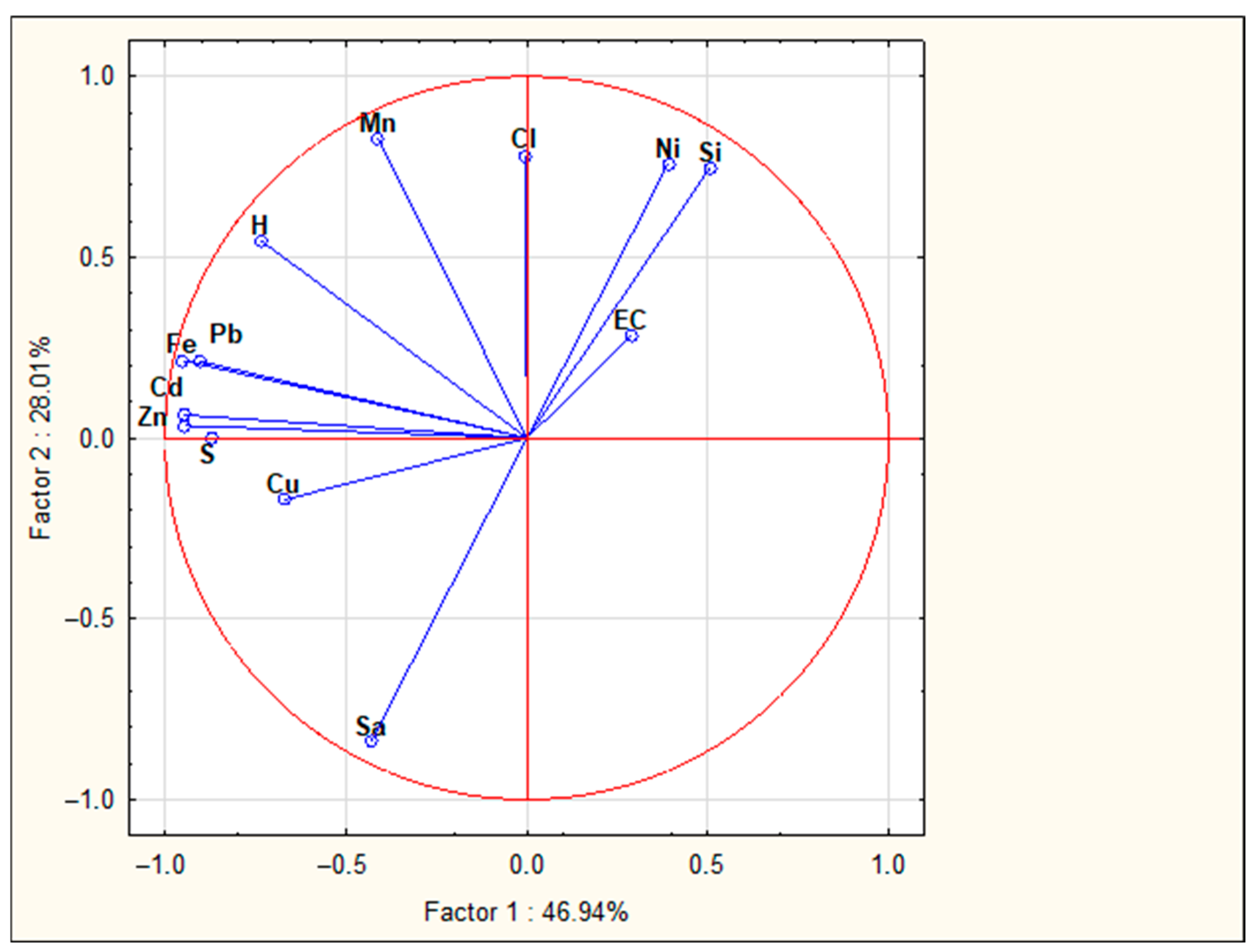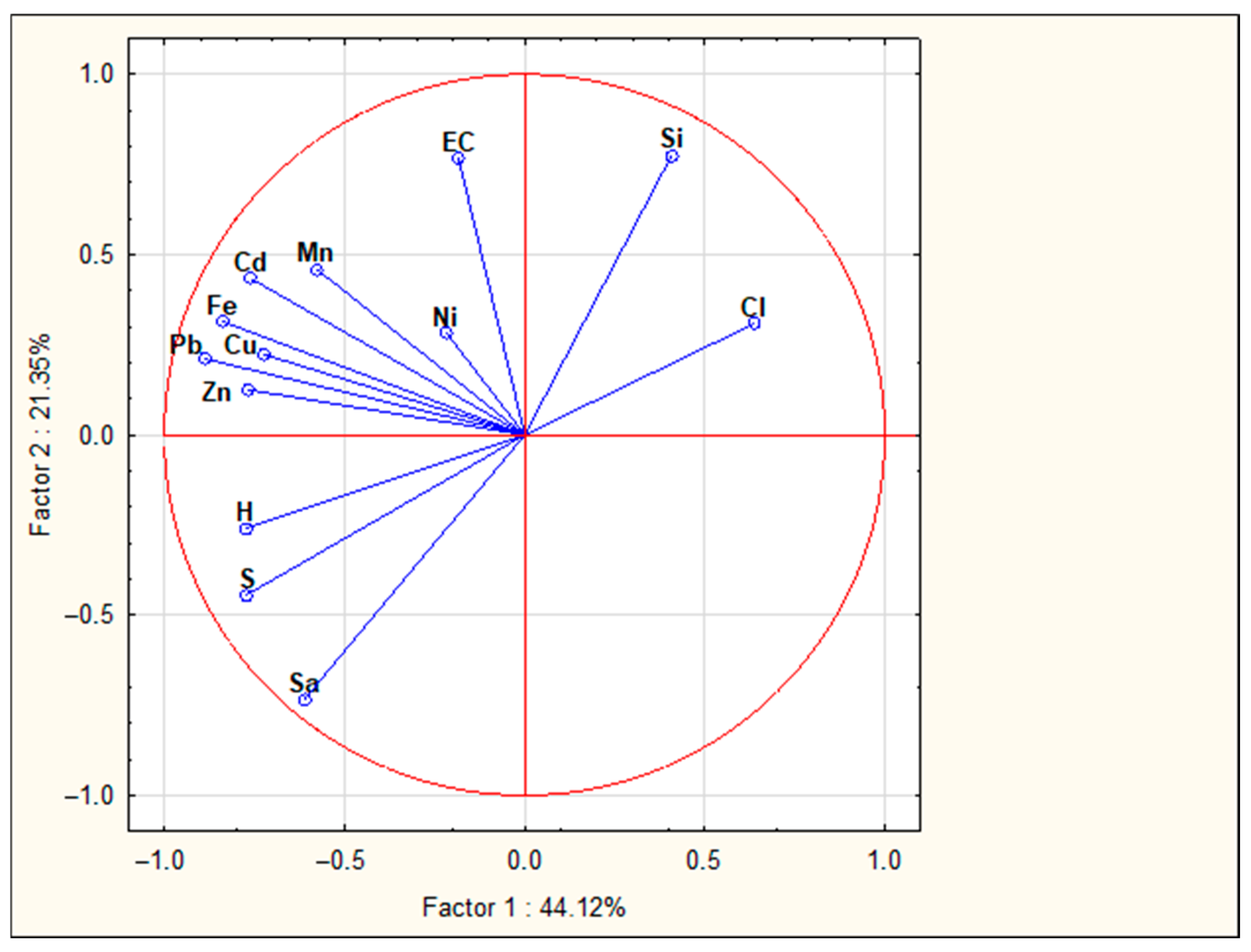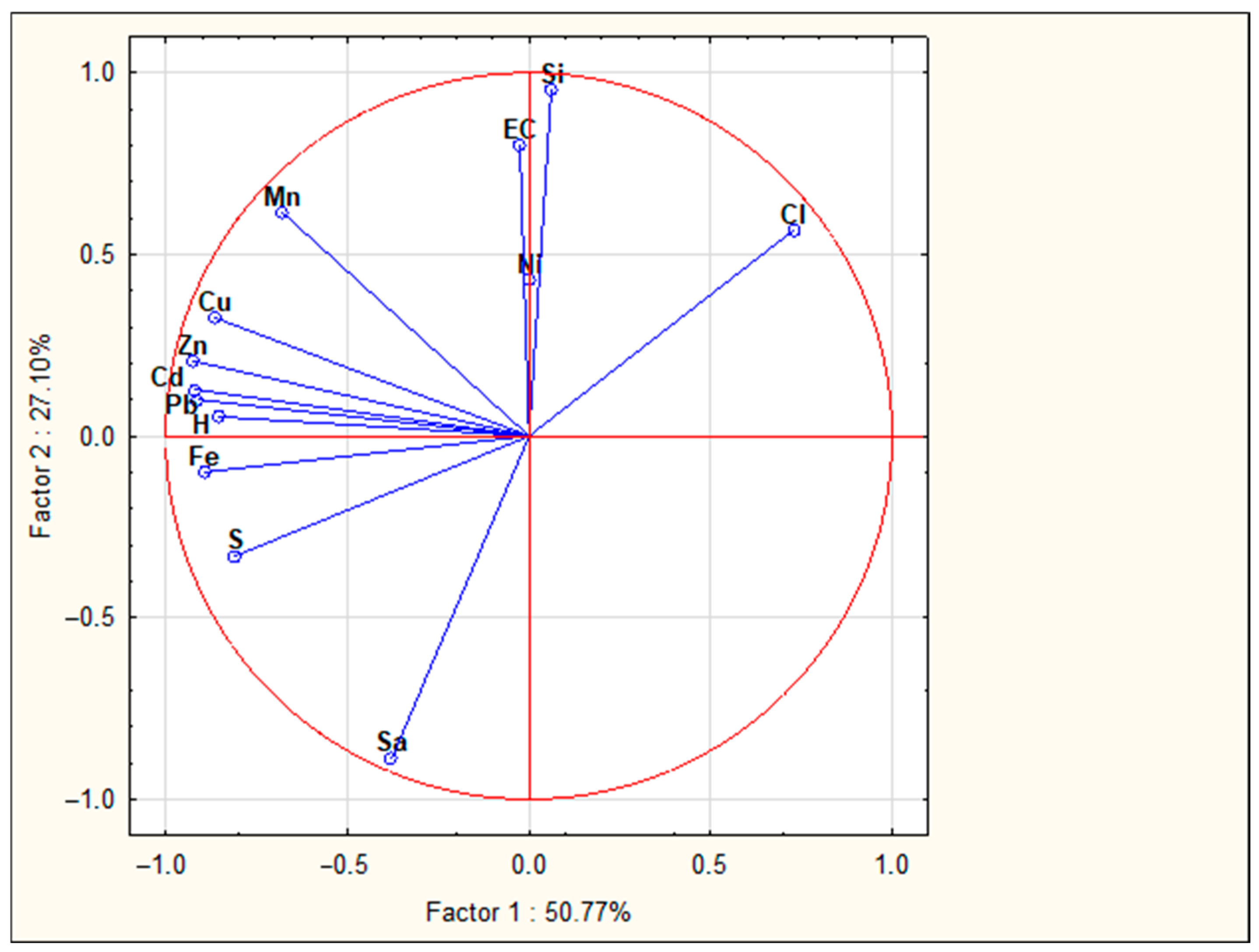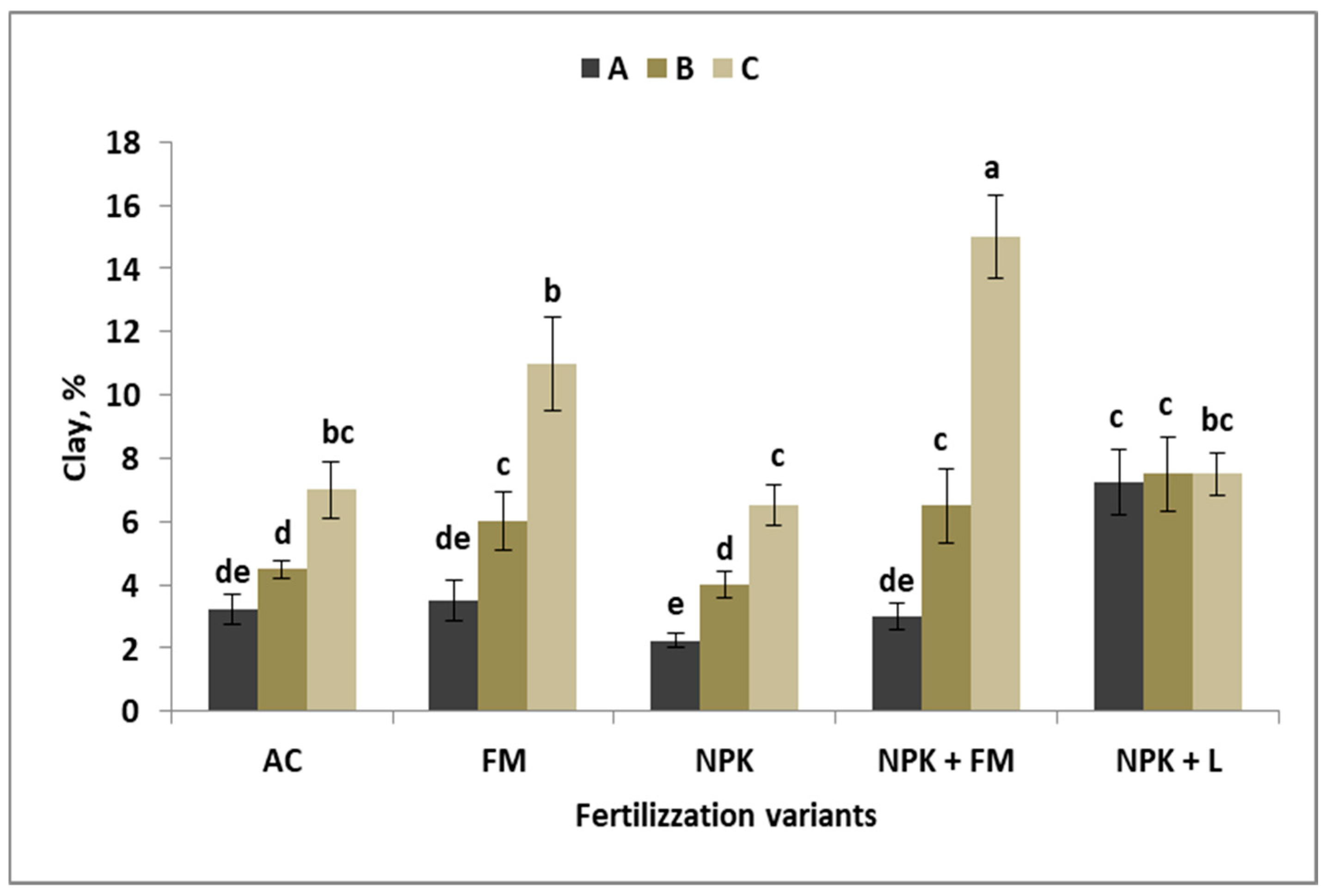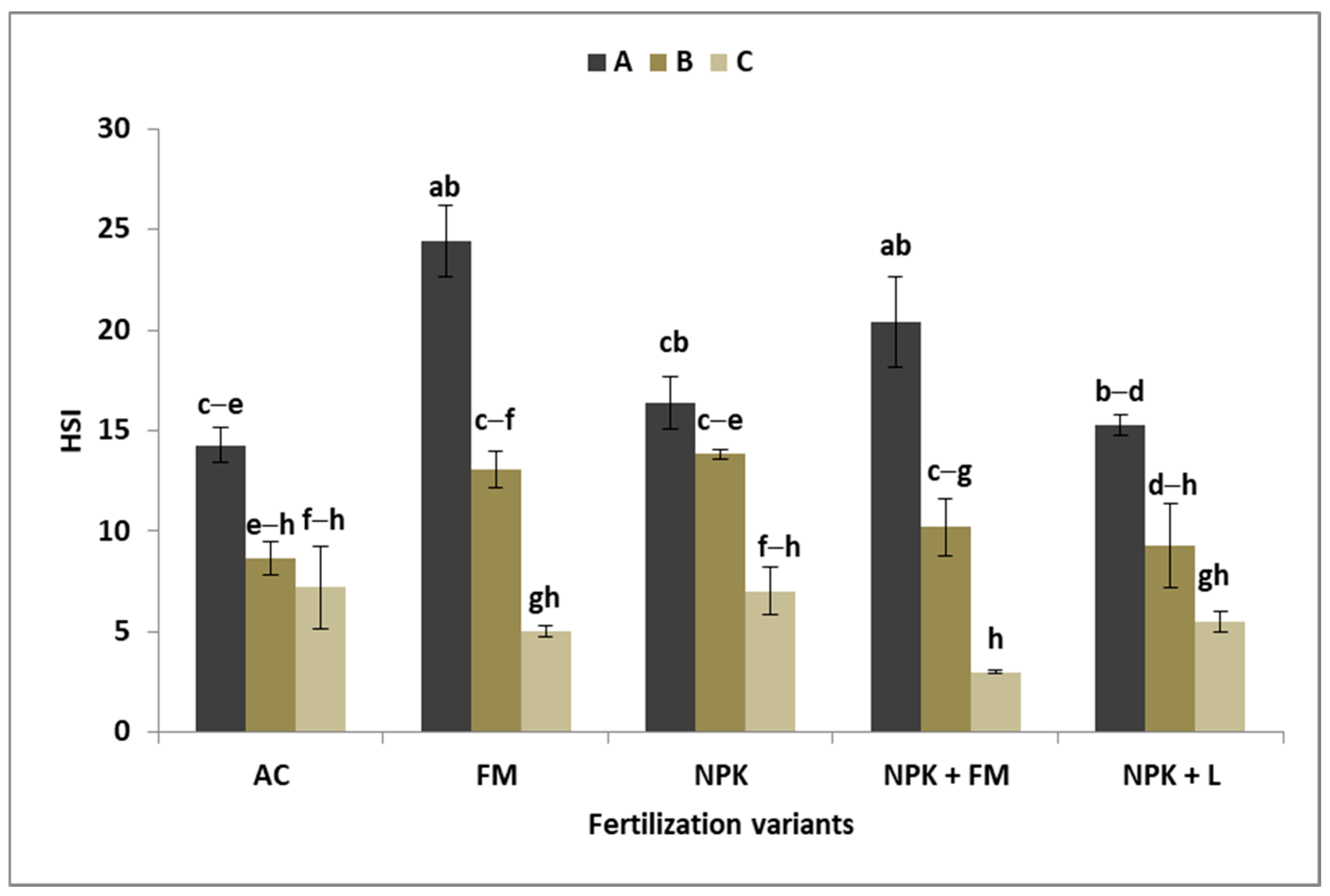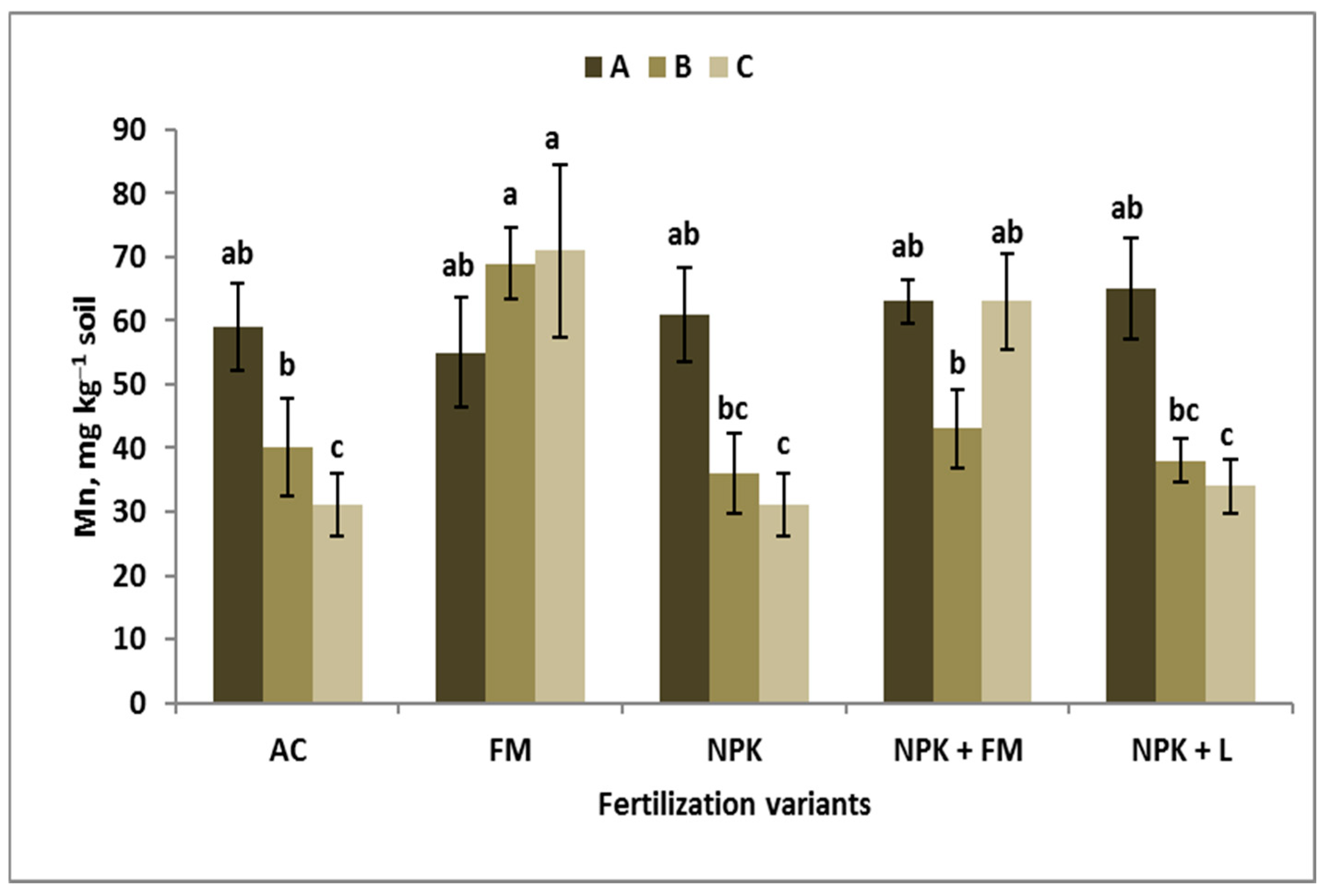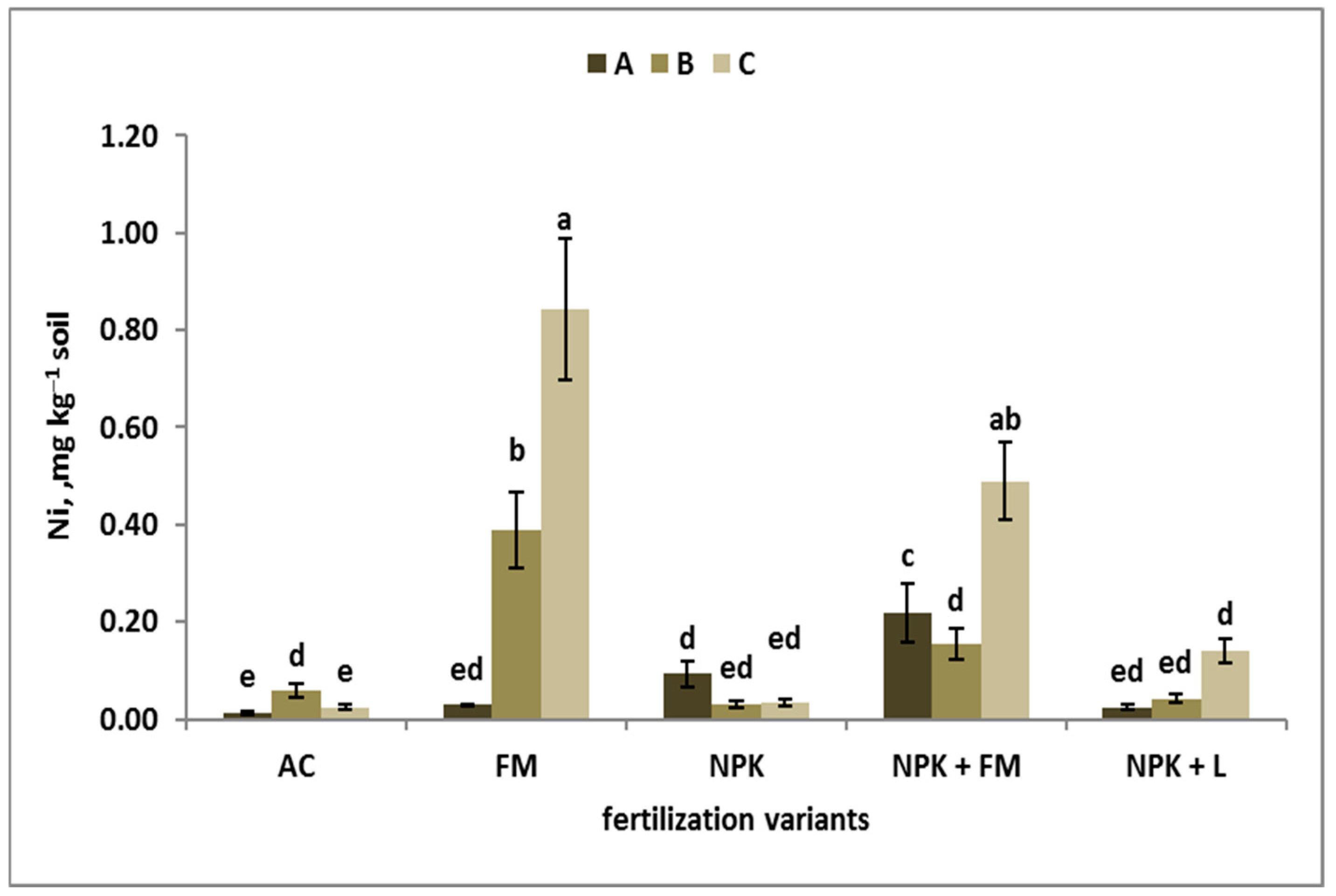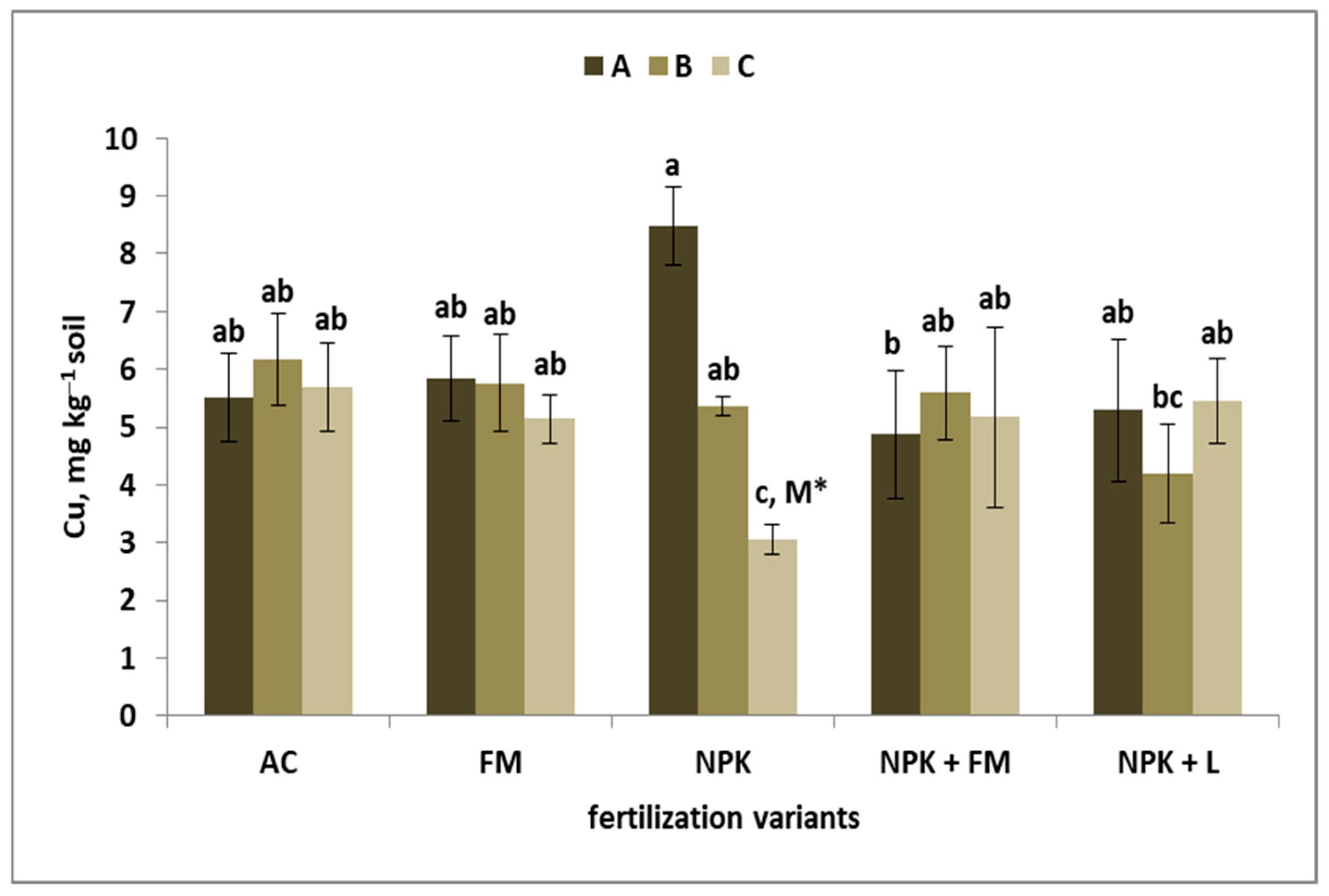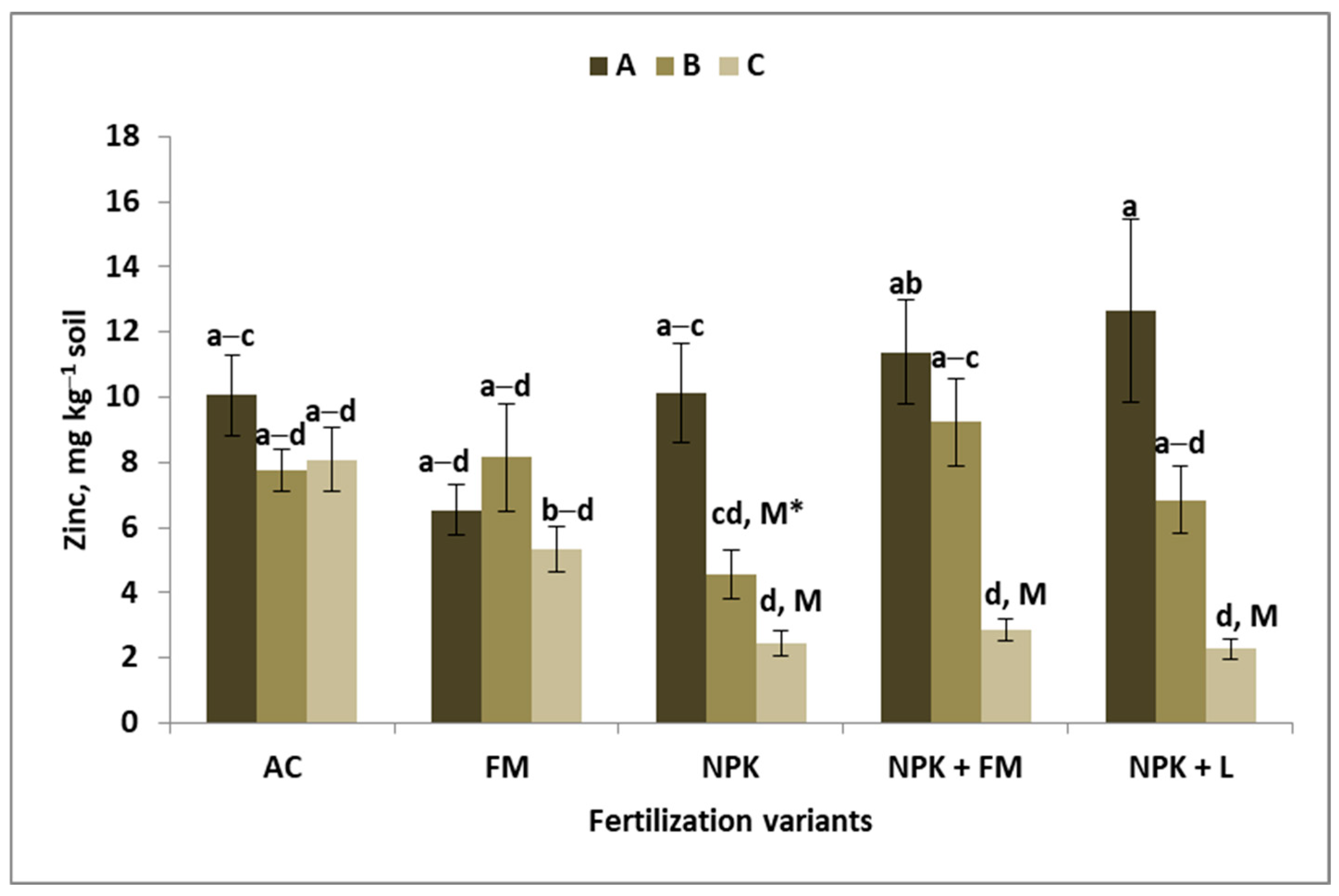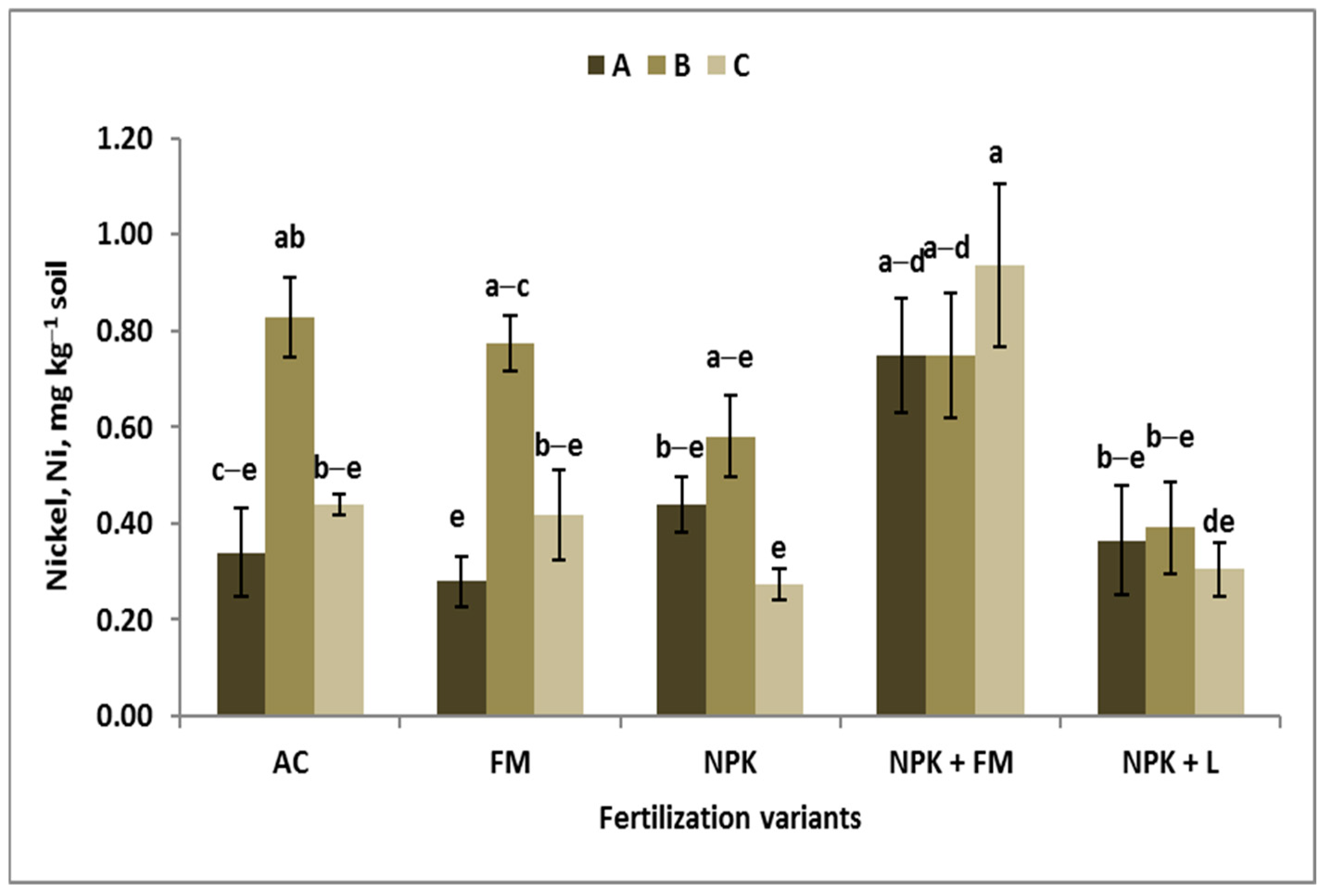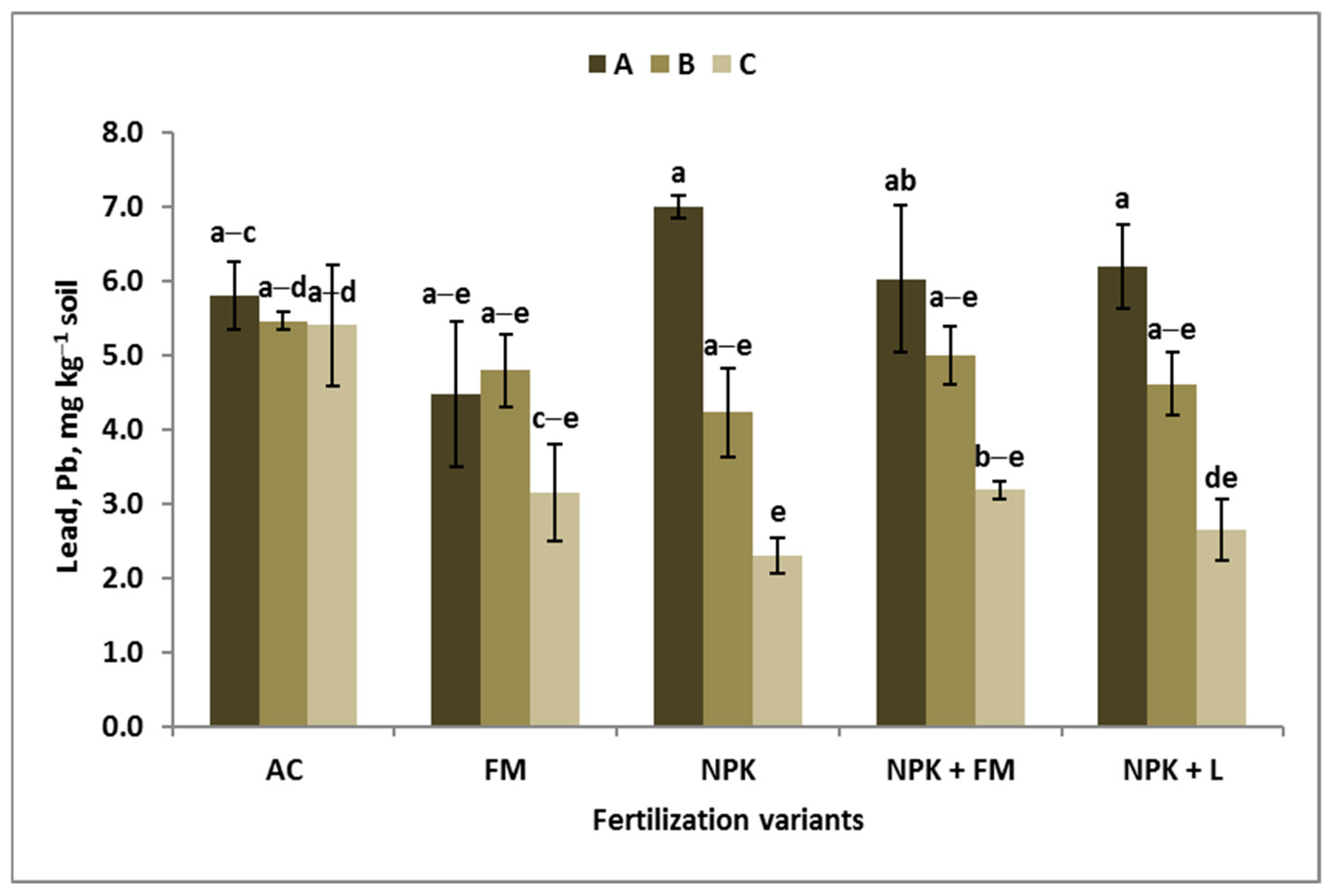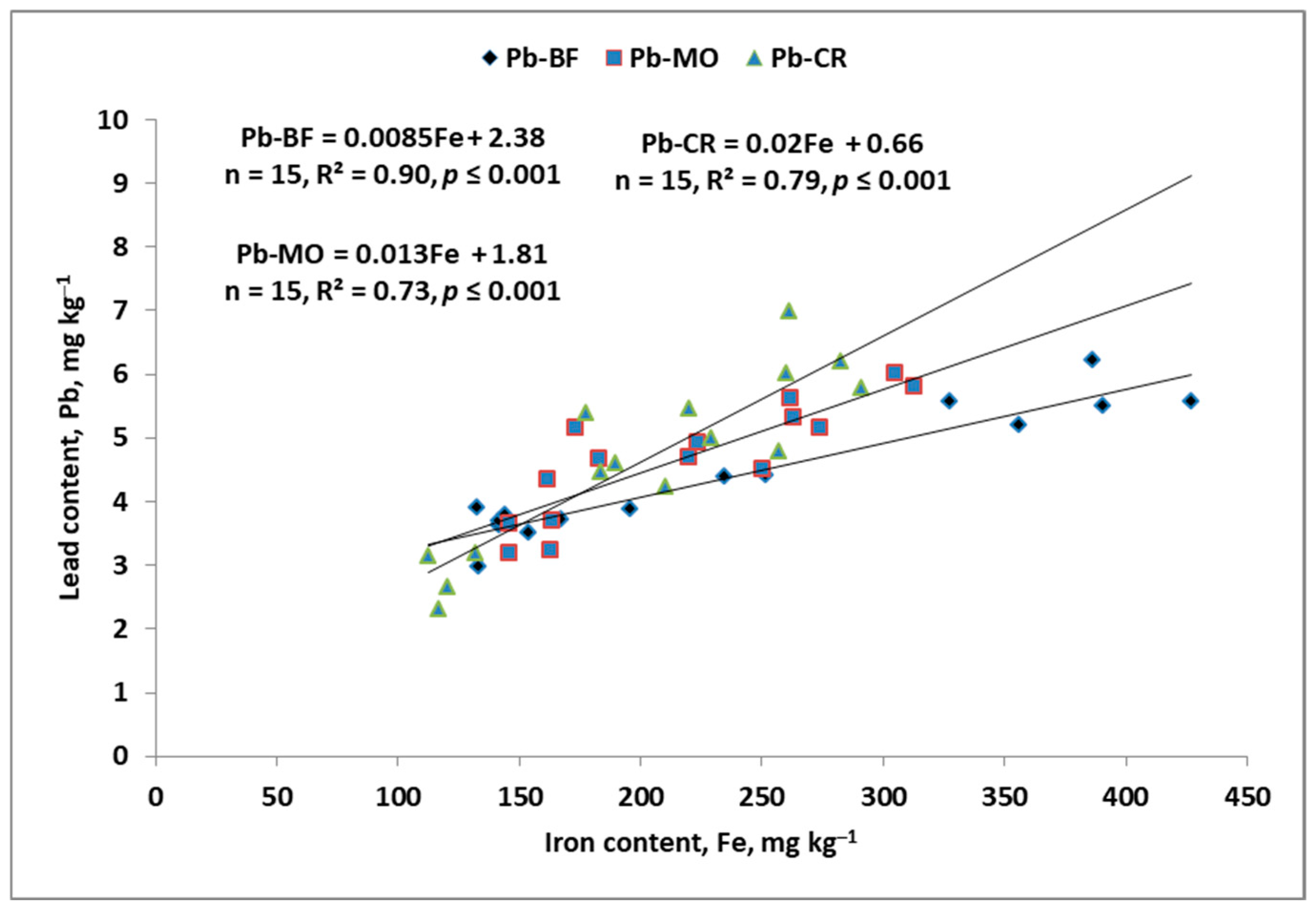4.1. Soil Fertility Status—Indicators of Soil Fertility Sustainability
The general state of soil fertility in a long-term field experiment, after 75 years of extremely different SUSs, was determined on the basis of four indicators, namely the soil texture, electrical conductivity (EC), soil reaction (pH), and organic carbon content (C
org, humus). It has been assumed that EC, as related to the concentration of nutrients in the soil solution, should reflect the long-term difference in the application of organic and mineral fertilizers [
39]. However, the conducted study did not show any significant differences in this soil characteristic in response to the tested FVs. It turned out to be a significant predicator of Ni content, but only in WW-CR. However, the level of prediction was low.
The long-term experiment on which the present study was conducted in the 75th year was established on a soil classified as Luvisol. This type of soil covers 45% of Poland’s area [
40]. In humid climates, fine soil particles (silt, clay), along with humus and Fe and Mn oxides, are transported down the soil profile. In consequence, the topsoil layers (eluvial horizons A and E) are subject to the depletion of these components, and at the same time, the deep soil layers are enriched with them (illuvial horizon, Bt) [
41]. Eluviation/illuviation processes are considered to degrade soil fertility [
42]. The consequences of these processes were clearly noted in the experiment, regardless of the SUS. The observed changes in the soil profile included basic granulometric fractions. The increase in sand content, which dominated, had a greater impact on silt than on the clay content. The value of R
2 (coefficient of determination) in BF was 0.95 and 0.43 for Si and Cl, respectively. In WW-MO, it was 0.79 and 0.47, respectively. A significantly different tendency was observed in WW-CR, where the respective R
2 values were 0.86 and 0.72. The downward trend in Cl distribution with soil depth was strongest for NPK + FM (CV = 76%). Only a weak trend was found for FM (CV = 56%). In contrast to the effect of manure, a stable and high clay content in the entire soil profile was recorded in NPK + L with 1.0 t CaO·ha
−1 applied annually. A similar stabilization action of lime was observed in WW-MO. The extreme impact of both FVs on the clay vertical distribution can be explained by the role of cations incorporated into the soil in applied fertilizers and their products (mineralization of manure and crop residues) on the charge of silicate clay colloids. Continuous application of Ca
2+ increases the aggregation of clay colloids, which in turn increases their stability and consequently prevents downward movement. The effect of manure (mineralization), in interaction with alfalfa, whose roots acidify the rhizosphere, is the opposite, ultimately leading to the disintegration of colloid aggregates and facilitating their transport in the soil profile [
43]. Lime therefore plays a stabilizing role in the clay content of the topsoil in Luvisol, preventing its degradation. It can therefore be considered an agronomic measure responsible for the sustainability of soil fertility. However, there was no significant effect of soil mineral fractions, regardless of the soil use system or fertilization variants, on the content of the studied elements.
Soil reaction is a key indicator of soil fertility, as it is considered to be sensitive to the SUS and fertilizers applied [
44]. The expected differences were observed, but they were not large. The long-term SUS had a moderate impact on soil pH, which increased in the order BF (6.1) < WW-MO (6.4) < WW-CR (6.6). The obtained series confirm the role of crop rotation in maintaining the sustainability of soil fertility. The obtained order emphasizes the role of the grown plants, or more specifically, organic residues, on the cation balance [
20,
45]. Generally, there was a slight increase in pH with soil depth, regardless of the other factors studied. A significant effect of applied fertilizers on soil pH was found for BF and WW-MO. In both cases, the lowest pH of approximately 6.0 was recorded in the FM variant. The difference between FM and NPK variants indirectly indicates the buffering role of nutrients introduced with mineral fertilizers. This conclusion is confirmed by the higher pH values in NPK than in NPK + L, where 1.0 t CaO·ha
−1 was applied annually. The relationship between pH and the contents of the micronutrients tested was, as a rule, negative, and they were significant only in BF. This is a natural, geochemical phenomenon that has also been documented in long-term experiments [
46,
47]. The most important fact, however, is that these negative relationships included heavy metals. However, it is more difficult to explain the negative effect of pH on the C
org content (C), proven in BF. The obtained relationship is presented below:
The obtained trend results from two natural geochemical phenomena: In mineral soils, the C
org content decreases, while the pH increases with soil depth [
48].
The content of the tested elements in the studied soil was determined by the humus content. Soil organic matter is a crucial indicator of soil fertility in mineral soils [
49]. There are different indices for soil organic matter status evaluation. The most frequently used is the content of C
org (humus) in the topsoil layer. The status of this characteristic can be assessed using standardized ranges. The most objective evaluation, reflecting the variability in C
org content, was obtained by applying local (national) ranges [
50]. The main limitation of an objective, realistic evaluation of soil fertility is the threshold range, which relates only to the topsoil layer. Without taking the subsoil into account, the assessment of the current state of soil fertility is incomplete [
51,
52]. Moreover, the analysis of the level of soil saturation with humus, without taking into account the soil texture, leads to erroneous conclusions [
53]. In this study, a reliable assessment of the humus content, taking into account the soil texture in subsequent soil layers, was carried out based on the Humus Stability Index (HSI) [
38]. The HSI values for the examined FVs amounted to 8 ± 2 on average for BF. NPK had the lowest index of the entire studied soil profile, thus indicating a high risk of soil degradation. In the topsoil of this variant, the C
org degradation compared to FM reached 42%. This phenomenon also occurred in the subsoil layers of the AC and NPK + L variants. Therefore, fallowing arable soil, even for several years, is not an optimal solution for sustaining soil fertility and therefore for sustainable food production. It leads to a drastic drop in yield [
54]. In winter wheat grown in monoculture, the average HSI was 13 ± 4.2, whereas in crop rotation, this index reached 15 ± 3. In both cases, the soil was in a state of humus saturation in the entire soil profile. It can therefore be concluded that the C
org content in the topsoil of 10.5–11 g·kg
−1 was sufficient to reach the humus saturation status. The required range of C
org content in layer B was 7.5–8.5 g·kg
−1; in C, it was 5–6 g·kg
−1. This natural level of humus content was maintained by applying farmyard manure in the BF each year. The amount of dry matter introduced to the soil by manure was 4.2 t·ha
−1. In the case of winter wheat, in monoculture and crop rotation, the required humus threshold content was exceeded solely on the basis of the harvest residues left in the NPK variant. No decline in carbon stock was observed in cropped soil, as found in other long-term experiments [
55]. It is important to emphasize that this assessment was based on soil texture and not on the initial C
org content. The low requirement for organic matter to maintain an appropriate humus content results from the potentially low degradability of crop residues. This is due to both the larger amount of lignin introduced with crop residues and the smaller amount of nitrogen introduced [
56]. However, the examined soil, compared to the standardized European Luvisol, contains approximately 75% of the humus stock in the soil layer 1.0 m deep [
57].
4.2. Micronutrients—Indicators of Soil Sustainability
How the content of the examined nutrients changes with soil depth in response to the SUS and long-term constant application of fertilizers is a question that needs to be addressed. First of all, though, the downward trend in C
org content should be assessed. It is well documented that humus is both the key soil component (pool) and a factor determining the availability of micronutrients to crop plants [
48]. The order of steepness of C
org decreasing with soil depth was MO ≥ CR > BF. It is worth knowing that its content in the topsoil layer of cropped soils was twice that in BF. These differences, despite a lower C
org content, remained in the subsoil. The greater humus accumulation in the topsoil resulted from the systematic input of organic matter from crop residues, while in BF, the only source of fresh organic matter in two of five variants was manure [
56].
The key factor in the observed variability in the content of available micronutrients was iron (Fe). Its average content in the entire soil profile was in the medium availability class and decreased in the order BF (239 ± 109 mg·kg
−1) ≥ WW-MO (217 ± 58) ≥ WW-CR (203 ± 62 mg·kg
−1). As a rule, it showed a decreasing trend with soil depth. At the same time, the stability of C
org-Fe associations decreased in the following order: BF (Linear, R
2 = 0.66) > WW-CR (Quadratic, R
2 = 0.62) > WW-MO (L, ns.). The strongest dependency between both soil characteristics was found in the non-cropped soil. The binding strength of the C
org–Fe soil complexes generally increases in the range of 0–20 g C·kg
−1, becoming stronger when the pH decreases below the pH range, called a “window of opportunity” [
58,
59]. The first condition was fully met in BF. In the WW monoculture, this did not apply to the topsoil in FM, NPK + FM, and NPK + L. Excluding these analytical units (soil layers) caused the C
org × Fe relationship to become significant (L, R
2 = 0.58). In WW-CR, the exclusion of the same set of units resulted in the linearity of the discussed relationship (L, R
2 = 0.66). This short analysis fully confirms the opinion of Ye et al. [
58]. The second aspect concerns the geochemical reasons determining the strength of the C
org–Fe complex. The key factor is the mineralogical status of Fe compounds in the soil, which strongly depends on the soil pH [
60]. In the studied case, the soil pH was just below the lower range of the transition range (or “window of opportunity”) of 6.3–7.0 pH [
59]. In this pH range, Fe oxides have a positive charge that is greater the lower the degree of crystallinity is [
61,
62]. Hence, the content of available Fe was higher in BF and lower in the subsoil layers and topsoil layers in MO and CR objects with FM and/or lime. The content of available Fe in the soil can therefore be treated as an indicator of soil fertility instability.
The content of available Mn in the soil, regardless of FVs and soil layer, was in the medium class. The obtained trend was as follows: WW-CR (69 ± 9) > WW-MO (51 ± 7) = BF (51 ± 15 mg·kg
−1). For Zn, the trend was similar: WW-CR (7.2 ± 3.2) > WW-MO (5.7 ± 1.4) ≥ BF (5.4 ± 2.2 mg kg
−1). At the same time, the values of the coefficient of variation were 45%, 25%, and 40%, respectively. These two series confirm the role of crop rotation in maintaining the sustainability of soil fertility. In WW-CR, the drop to the medium class occurred only in layer C, and in BF already in the entire subsoil. The obtained order resulted from two facts. First, the forecrop for WW grown in crop rotation was alfalfa. Secondly, the mass of crop residues per 1 kg of N in the soil/crop system was lower than in the WW monoculture [
56]. In the case of Mn and Zn, the downward trends coincided with the content of humus, which was the highest in CR. In subsoil with winter wheat, the C
org content was lower, and at the same time, the pH was higher. The coincidence of these two soil characteristics resulted in a decrease in the content of micronutrients while being in line with the amount of C
org. The obtained results confirm studies that showed that the resources and availability of Zn in Polish soil are critical for winter wheat [
63]. The latest research has shown that, for the formation of the yield structure of winter wheat, which yields at a very high level, Zn is a critical factor [
64,
65]. In the case of Cu, its content was in the order WW-MO (5.4 ± 1.1) > WW-CR (4.8 ± 1.2) = BF (4.7 ± 0.9 mg·kg
−1). The variability of the results was low because the coefficient of variation was 21%, 24%, and 20%, respectively. These values indicate the dominance of variants, especially in winter wheat with a high content of available Cu.
The content of available Fe, regardless of the system of soil use, affected the contents of other micronutrients. The strongest relationship was recorded for Zn (
Figure 9). The strength of the obtained relationship decreased in the following order: BF ≥ CR > MO. However, the rate of Zn content increase, in response to an increase in Fe was almost three times greater in CR. The association strength of Fe and Cu was significant but much weaker than that of Zn. It decreased in the following order: CR > MO > BF. The lowest strength in the studied relationships was found for Mn, which was positive but significant only in BF. The greater mobility of Zn over Cu in the tested soil, regardless of its long-term SUS, can be explained by the values of the first hydrolysis equilibrium constant (
pK1). It is lower for Cu (pH 6–8) than for Zn (8–9), which results in greater adsorption of Cu in the soil in response to increased pH [
66]. The study on the adsorption of trace elements in the examined experiment fully confirmed this rule. The adsorption maxima (a
max) of the Langmuir equation was three times higher for Cu compared to Zn [
67].
4.3. Bioavailable Heavy Metals—Controlling Factors
A remaining question is how the long-term, one-sided use of organic and/or mineral fertilizer affects the content of a bioavailable pool of heavy metals. It has been well documented that using EDTA (ethylene-diaminetetraacetic acid, EDTA), present in the Mehlich 3 extraction solution, allows for a reliable estimation of the bioavailable Pb and Cd pools in soils [
68,
69,
70].
The basic sources of Pb and Cd in the long-term experiment were manure and mineral fertilizers. With respect to cow manure, the amount of introduced Pb into the soil annually was approximately 19 g·ha
−1 and Cd of 1.4 g·ha
−1. The second source for all tested NPK variants was phosphorus fertilizer, applied in the form of single or triple superphosphate. The average content of Pb in P fertilizers is 30 mg·kg
−1 and 0.8 mg Cd·kg
−1 [
71]. The amount of heavy metals actually incorporated into the soil annually with P fertilizer was low (Pb—1.4 ± 0.2; Ni—1.0 ± 0.05; Cd—0.6 ± 2 g·ha
−1·year
−1). In NPK + L, the maximum annual dose of Pb did not exceed 100 g·ha
−1. Despite the differences in the amounts of heavy metals introduced into the soil from external sources, their content in the examined soils was very similar.
One of the most important dependencies observed in this study was the relationship between the content of available Fe, regardless of the type of long-term SUS, and the bioavailable Pb (
Figure 10). Similar relationships were obtained for Cd. The rate of Pb increase, in response to increasing Fe, was in the order CR > MO > BF. This dominant role of Fe, as a driver of Pb content, did not result from the use of manure but probably from the geochemical processes responsible for its release from soil pools. The first hydrolysis equilibrium constant (
pK1) for Pb is approximately 6, leading to a fast inactivation of Pb
2+ in the soil solution around this pH value [
66,
72]. The content of available Pb was the highest in CR, in which both the content of C
org and pH were the highest, resulting in a strong release of Pb and Cd. However, the content of Zn, as known from a stepwise regression analysis, was a better predictor of bioavailable Pb than Fe. Therefore, we cannot ignore the role of crops grown in crop rotation. Alfalfa was a direct forecrop for winter wheat. The effect of this crop on element mobility in the soil is multifunctional. Firstly, it acidifies the rhizosphere, even up to two units below the measured value in non-rhizosphere soil [
73,
74]. Secondly, this crop takes up nutrients from a great depth and accumulates them in the topsoil. This was evidenced for both Zn and Pb in the NPK variants. Thirdly, the alfalfa crop residues are richer in N and, at the same time, poorer in lignin compared to winter wheat residues, as evidenced by this experiment after 30 years [
56].
Each of the heavy metals examined responded individually to the long-term system of arable soil use and the continuous application of organic and mineral fertilizers. The average Pb content in the soil of the studied objects remained almost constant. Its distribution depending on soil depth was very similar, but the rate of decline was in the order CR > BF > MO. This series confirms the dominant role of crop rotation in controlling the content of available Pb in the soil. In BF and MO, Pb vertical distribution followed the distribution of C
org, being highest in the topsoil. A significant impact of the fertilizers applied was only found in CR. Fertilizer variants with NPK were characterized by the highest Pb content in the topsoil and a gradual decrease with soil depth. The decrease in Pb content in the subsoil and simultaneous increase in the topsoil indirectly indicate its dependence on the humus content, which did not appear in AC and FM. The drop in Pb content in FM and its much higher values in AC are probably due to the higher yields of winter wheat and the potential for its removal from the soil [
12].
The threshold value of 0.27 mg Cd·kg
−1 was exceeded only in BF. At the same time, it decreased gradually with soil depth. In cropped soils, the Cd content was below this critical value but also showed a significant decreasing tendency with soil depth. The rate of decline was twice as high in CR compared with MO. The opposite trend for the Cd content in relation to the C
org content indirectly suggests its depletion due to uptake by growing plants. The magnitude of the decline indicates that it was much higher in CR, where the WW yield was much higher compared to MO [
12].
The key factor affecting the content of bioavailable Ni was the long-term SUS. The highest content was recorded in WW-CR—three times higher than BF and 2.5 times higher than WW-MO. The observed differences can be easily explained by the fact that the forecrop for WW in crop rotation was alfalfa and WW in monoculture. Alfalfa takes up and accumulates during the growing season a relatively large amount of Ni to control the processes of urea transformation into nitrogen compounds [
75]. The content of Ni in alfalfa hay ranged from 2.0 to 2.5 mg kg
−1 and in winter wheat from 0.05 to 0.3 mg·kg
−1 [
76,
77]. The mass of crop residues in the second alfalfa growing season in the studied experiment was approximately 5.5 t·ha
−1 dry matter (including 2 t·ha
−1 root biomass in the topsoil layer). At the same time, the C:N ratio ranged from 18 to 21. For comparison, the harvest residues of winter wheat amounted to approximately 3 ha
−1 (including 2 t ha
−1 root biomass in the layer of 0.0–0.3 m), and the C:N ratio ranged from 30(35):1 for roots to 50(65):1 for stubble [
78]. A comparison of these two datasets at least partially explains the difference in soil available Ni content between WW-CR and WW-MO.
In BF, the content of Ni averaged for the entire soil profile does not reflect the real content, depending on the fertilization variant. In AC and NPK variants, excluding NPK + FM, the average Ni content was below 0.1 mg kg
−1. In FM, it reached 0.42 mg·kg
−1, and NPK + FM 0.29 mg·kg
−1. At the same time, its content increased strongly with soil depth, especially in FM. This tendency suggests Ni leaching. It has been documented that Ni cations create complexes with organic acids, which accelerates Ni movement into the deeper soil layers [
79]. At the same time, the increase in pH reduces the Ni pool’s susceptibility to leaching [
75]. This phenomenon was observed in NPK and MPK + L variants in CR.
